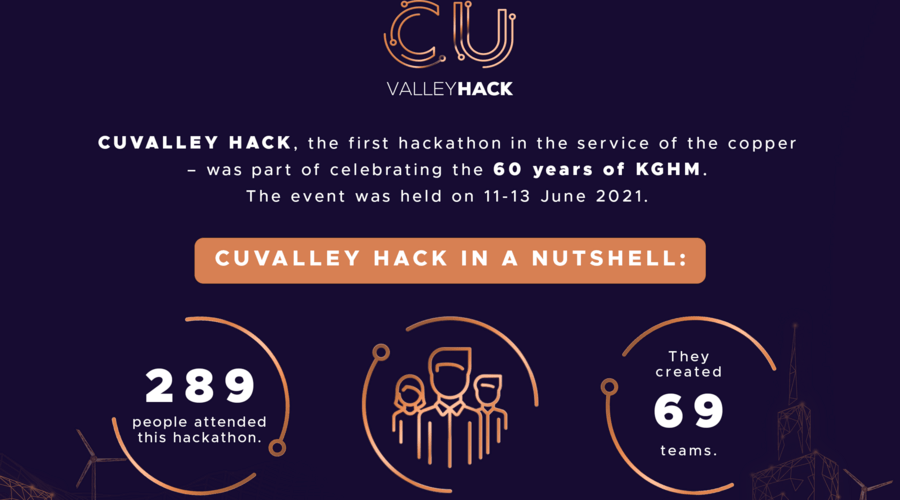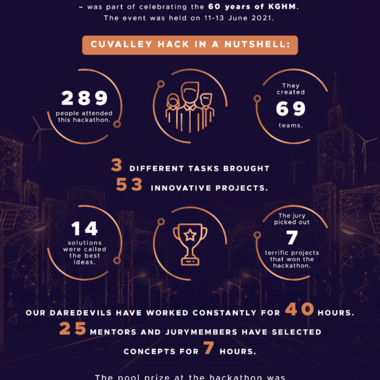Copper hackathon concluded - meet the winners of the programming marathon on the occasion of the 60th anniversary of KGHM Polska Miedź S.A.
The first hackathon organised by KGHM CuValley Hack 2021 has come to an end - nearly 300 participants took part in the competition and managed to create 53 projects. Participants coded continuously for 40 hours, across 3 different task categories. The prize pool of the hackathon amounted to PLN 100 thousand.
"KGHM is a mining giant, but above all it is a technology company. We incorporate technology into what we do and the more such innovations, especially in recent heavily digital times, the better for us. As KGHM, we are extremely proud to have been able to run a hackathon that was very well received and attracted widespread interest in the IT world. We thank the participants for their projects. They were all interesting, so the jury had a difficult task in selecting the presented solutions. However, such are the laws and rules of the hackathon that only the best can win", said Marcin Chludziński, President of KGHM Polska Miedź S.A.
The CuValley Hack participants focused on data analytics and the use of AI, Machine Learning or BigData in industrial automation systems. In practice, the solutions developed are expected to reduce failure rates in SMG machines, stabilise the operation of the slurry furnace and aid tremors prediction.
The first edition of the CuValley Hack hackathon was held under the patronage of Prime Minister, Mateusz Morawiecki. In addition, the winners of the hackathon received a prize from the President of Poland, Andrzej Duda, in the form of pens with a dedication to the winners.
KGHM is counting on practical implementation of the awarded projects, including ideas on optimising the operation of the flash furnace at the Głogów smelter, and on failure prediction in mining machinery. The CuValley Hackathon successfully merged the world of data science with industrial engineering.
List of hackathon winners:
In the SMG MACHINE DATA ANALYSIS category, the best projects were:
1st place
Team: PREDYKCYJNI KRK
Project: Gearbox failure detection in SMG.
Jury's rationale: Professional work, presenting advanced analysis of data from self-propelled mining machines with potential for application and development in the KGHM environment. A strong subject knowledge of the operation of machine systems ensures an understanding of the field issues and selection of appropriate methods for further analysis.
A few words from the team: As part of the task, an exploratory data analysis was carried out on the basis of which guidelines were developed for processing the data into a structure allowing identification of the variability of selected parameters for two operating states of the machine in relation to specific operating conditions in a daily cycle (normal and pre-emergency, 4-shift system).
2nd place
Team: PBP TEAM
Project: First the wise man's glass and eye - then perceptrons.
Jury's rationale: In the presentation, the team showed the effect in terms of forecasting and alerting on the occurrence of an accident. We see potential for application here and want to verify the proposed methods for a larger dataset.
A few words from the team: The project involves facilitating rapid visual verification of failure detection theory hypotheses, providing an intuitive 'data drill' interface, using unsupervised and supervised learning algorithms for failure prediction / identification of pre-failure states. The developers focused on gearbox failures in WOS machines.
3rd place
Team: CUPRUM INSIGHT
Project: Failure time forecast.
Jury's rationale: An encouraging solution for the application of prediction of failure occurrence of self-propelled mining machines. The high prediction rates obtained made the Jury want to continue the cooperation and verify the application of the solution in a production environment in the near future.
A few words from the team: Using the example of a gearbox failure in a dump truck, the developers show that it is possible to build a prediction of the remaining running time using recurrent neural networks.
Additional distinction - DATA MINERS
Jury's rationale: An interesting idea to solve the application layer and a comprehensive approach to the project, from model to application. The jury, appreciating this approach, would like to establish further cooperation with the team.
A few words from the team: MADSztygar is an advanced analytical tool, using solutions from the area of machine learning, time series analysis, feature engineering, in the service of searching for relations between failures of mining machines and indicators describing these machines. The solution has a convenient RShiny-based graphical interface for easy interaction with modelling results.
In the category of STABILISATION OF THE FLASH FURNACE OPERATION, the Jury selected the two best projects. The submitted concepts were evaluated for the greatest potential for production implementation and the most innovative approach to solving the problem.
1st place
Team: DATA DRIVERS
Project: Furnace operation stabiliser.
Jury's rationale: First place was awarded to the DATA DRIVERS team, who presented a project involving a fairly accurate loss-producing model and a fairly simple-to-implement optimisation algorithm.
A few words from the team: The project consists of three parts: scripts that process source data, a total loss model of a flash furnace and a Flash Furnace Operation Stabilizer, and simulation and visualization of its operation.
2nd place
Team: ANZONIA
Project: Flash furnace operation optimisation.
Jury's rationale: Second place was awarded to the ANZONIA team for a reasonably optimal predictive model and a non-trivial genetic optimisation algorithm.
A few words from the team: Based on the regression model, we were able to simulate the furnace operation to find the most favourable parameters at a given time. For optimisation purposes, we have prepared a genetic algorithm that has the ability to learn and adjust variables over time intervals. With the help of a generic algorithm, the controller is able to simulate and react to the heat balance in such a way that it is as favourable as possible.
In the final category of TREMORS PREDICTION, the Jury selected two winning teams.
1st place
Team: ŚWIEŻAKI
Project: Calm before the storm: a fresh approach to tremors
Jury's rationale: "A fresh approach to tremors in Rudna mine" according to the JURY of the competition defined the problem of attempting to predict tremors most closely and accurately by analysing the total amount of energy given off by the rock mass during mining. Of course, the proposed model has yet to be validated, as the organisation of work and the movement of the mine depend on the effectiveness of the forecast.
A few words from the team: In our project we have created a machine learning model for tremors prediction, which is based on observing an "energy pool" that we have defined. We assume that rock-forming forces and rock stresses must find their outlet and that seismic phenomena are natural.
2nd place
Team: KGIS
Project: Prediction of seasonality of a phenomenon occurrence
Jury's rationale: The team presented trends and seasonality of tremor occurrence in the RG, RZ and RP mining areas of Rudna mine. As with 'Świeżaki', it will be crucial to test the algorithm in motion tests.
A few words from the team: Although it is not possible to accurately predict the location, time and energy of a tremor, it is possible to somewhat narrow the range and specify periods of increased risk, which can translate into improved safety and protection of workers' lives.





